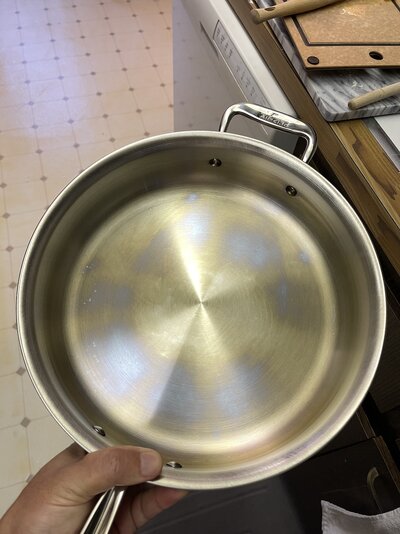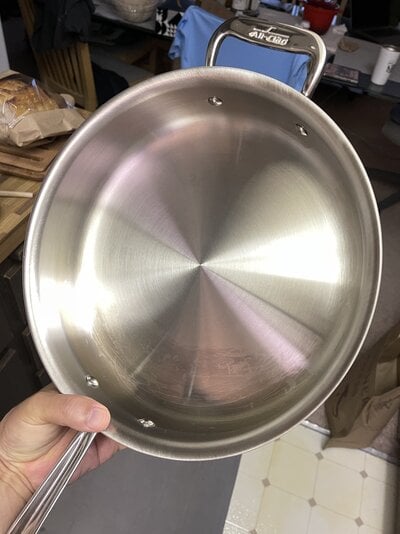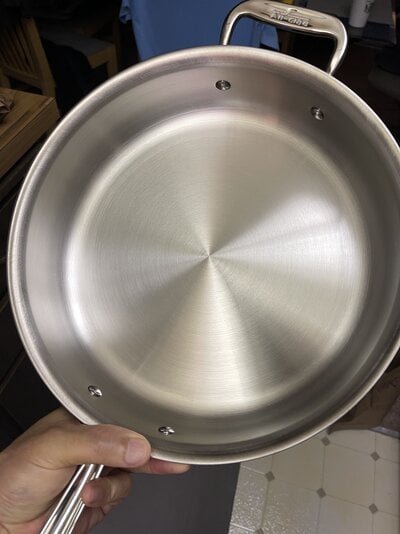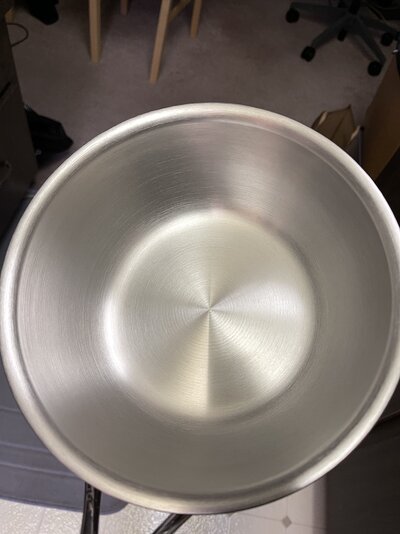Carlo_M
Senior HTF Member
- Joined
- Oct 31, 1997
- Messages
- 13,392
TL;DR (or as the old fogies referred to it, the Cliff's Notes version)
I am super impressed with the craftsmanship, quality and cooking results of the Demeyere Atlantis/Proline/Silver7 cookware. Many high-end cookware reviewers claim it's a superior line to All Clad's D3/D5 lines, which is considered the industry standard and used in professional kitchens and by well-known chefs around the world. After using them, I can understand why some make that claim. It's not a criticism of All Clad (which is stellar). It's a testament to how incredible Demeyere is.
TIL
The surviving family members (who are still operating the company despite it being purchased by Zwilling, along with other brands like Staub) pronounce the name deh-meyer-uh (with the "uh" being a little rolled off, but most definitely audible), not deh-meyer. And the "meyer" part is pronounced like Oscar Meyer.
Background
With apologies for the trademark infringement of our dear friend and resident film expert/historian/restorer/all around great guy Mr. Robert A. Harris, I present my inaugural "way too many words about cookware" series (reflecting my penchant for lengthy, in-depth posts). There's actually a previous, true first post to this series, but I can't go back and change the title of that thread to make it the true first post about cookware. That one started off as a testimony to my foray into heirloom quality cast iron pieces (in an effort to eliminate nonstick cookware from my kitchen) and as Tolkien would say "the tale grew in the telling" that it started to include additional cookware type purchases I made such as enameled cast iron (Le Creuset, and a just-purchased Staub) and Demeyere. Initially I thought I'd keep it all in that thread, but as I've used each of these Demeyere pieces over the last several weeks and months, I have been so impressed with them.
Why did I purchase stainless steel (SS) cookware, when I have a nice assortment of Smithey cast iron and Le Creuset/Staub enameled cast iron pieces?
I wanted to cover all of the bases. Cast iron is wonderful, in fact perhaps the best, at searing meats and getting the Maillard reaction. But you also need to be careful when using acidic sauces/ingredients as that can strip the seasoning, and if you want to deglaze and make fond from the bits left in the pan, often you are using wine, which is acidic. I also wanted cookware that was a little lighter than cast iron, as Smitheys, LCs and Staubs are all some of the weightiest pieces out there. Don't get me wrong, The Atlantis/Proline/Silver7 lines of Demeyere are probably the heaviest SS pieces out there, as the fully cladded pieces are 7-ply all the way to their sealed edges (and it's important to have sealed edges as All Clad just settled a $4M class action lawsuit where their unsealed edges could lead to corrosion of the aluminum layer under dishwasher use). Sealed edges means the interior plies are not exposed to water or outside elements and should never corrode or delaminate unless you damage the pan through trauma.
Atlantis, Proline, Silver7, Oh my! What's the difference?
Essentially what I've discovered is this: Demeyere's top of the line SS cookware is all 7-ply, and named Atlantis and it's sub-category Proline. Proline generally refers to the fry pans, and Atlantis refers to every other pan/pot in that lineup (saute pans, saucepans, sauciers, stock pots).
So what's the Silver7 line? It's the line Demeyere makes specifically for Sur la Table, which is functionally identical in terms of number of plies and manufacture of the "important" parts of the pots/pans, but with some slight differences which I'll highlight later, as I have both Atlantis/Proline and Silver7 pieces. Essentially the shape and angle (relative to the pot) of the handles vary a little bit, as well as the shape of the weld point from the handle. As to which is "better" is totally buyer-dependent (I'll give my opinion on this later). Also the Silver7 lids are double walled (and hence thicker but not necessarily too much heavier since there's air between the walls), which some might prefer. I'm still too novice of a cook to know whether the double walled lids are better/worse than standard lids, and honestly I do most of my SS cooking with the lid off.
The two types of Demeyere 7-ply
For their fry pans and sauciers (which are like sauce pans but have sloped walls, as opposed to squared off walls), Demeyere uses a 7-ply cladded manufacture, which means all 7 plies are present throughout the entirety of the pan/pot (but not the handle). The bottom 3 plies for both types are what they call "TriplInduc" (like the two words tripl(e) and Induc(tion) smashed together), which is a proprietary three alloys that they claim make it superior to use on induction stovetops. While I have, and prefer, gas ranges, I know at some point being a California resident and our state's desire to get away from burning fuel sources, I'll probably have to go to an Induction top at some point. The cooking layer is 18/10 stainless steel with Silvinox treatment. After many uses, I can attest that the claims made there seem to be bearing out in the real world.
The cooking layer and the base TriplInduc layer are where the similarities end.
For the fully cladded pieces, sandwiched between those two are 3 layers of aluminum (an aluminum alloy sandwiched between 2 layers of pure aluminum). The infographic below shows the layers, but the "three layers of aluminum totaling 2.2mm" on the 7 ply is incorrect, or rather only applies to the woks. The saucier's (referred to as conic saute in the link) aluminum layers are between 3-3.3mm thick, and the Proline fry pans are 4.8mm thick. This bears out as I used digital calipers and the fry pan overall wall thickness is 5.3mm and the saucier is 3.6mm, so the difference is accounted for in the aluminum layers.

For the bonded disc pieces (saute pans, stock pots, sauce pans with squared-off walls), the sides are simply thin stainless steel layers (with the Silvinox treatment) but the disc bottom is where the magic (aka heat retention and distribution) happens. The disc bottom for both my 2.3 qt sauce pan and 3.5qt saute pan are both 18mm. Sandwiched between the steel and TriplInduc are three layers, a 2mm copper (one of the best heat conductors) disc which is the same size as the pan/pot, sandwiched between two silver layers. The thinking behind this design is that for the type of cooking one does in sauce pans, saute pans and stock pots, even heat distribution at the bottom is where it's most important, not the side walls, and that the type of cooking done in those pots relies on the convection effect of the food inside the pot. Also, to fully clad those pieces would make the super heavy (heavier than enameled cast iron dutch ovens).
What do the seven plies get you?
Other benefits of Atlantis/Proline/Silver7
For me, these are the ones I could identify (other people may identify more).

From left to right: 3.5qt Silver7 saute pan, 2.25qt Silver7 sauce pan, 9.5" Silver7 skillet (aka fry pan), 2.1qt saucier (aka conic saute pan)

The Silver7 sauce pan on the left, Atlantis saucier on the right. Note the double walled lid on the left vs. the single walled lid. Not significantly heavier: 0.92 lbs vs. 0.78 lbs although the lighter one is a little bit wider in circumference. Also note the rectangular weld contact point on the Silver7 (they all have this style) vs. the more "aerodynamic" (can't think of a better word) weld point for the Atlantis. I doubt both will ever fail, but I do think there is more contact area in the Silver7 weld point, but I have to say my eye likes the look of the Atlantis weld point more. Also note the Atlantis handle is more upward sloping, which I think is a consistent difference between the S7 and Atlantis.

Note the shape difference in the lid handles. S7 has the rectangular/more angled style, while the Atlantis is more smooth and rounded (mirroring the differences in weld points).

Disc bonded on the left (17mm with thick copper layer) and fully cladded on the right. Note the severe thickness difference at the nicely sloped (and sealed!) pouring rims. Whenever I have to "pour one out" there is very little, if any, dribbling down the sides.

Fully clad thickness comparison: fry pan on the left at 5.3mm, saucier on the right at 3.6mm
Comments, thoughts and experiences are welcome!
If you are a stainless steel cookware fan, please post your pieces and thoughts on them! All Clad gets most of the name recognition in America, but internet direct companies like MadeIn are also making headway into the market space, claiming "All Clad" quality at lower prices. Hestan is trying to carve out a niche in the "more expensive than Demeyere" space (however small that market space is ) and of course I'd love to hear from those who own copper pieces. Outside of the added cost of copper, I'm also a bit wary of the added maintenance to keep/restore the shine on copper, which is why to this point I don't own any copper pieces.
) and of course I'd love to hear from those who own copper pieces. Outside of the added cost of copper, I'm also a bit wary of the added maintenance to keep/restore the shine on copper, which is why to this point I don't own any copper pieces.
If there's enough participation and interest in this, I may do a second (third?) post in the CDC (Carlo Does Cookware) series comparing my Le Creuset and Staub pieces. The funny thing is that the basting dots on the lids of Staub ovens are called "Aroma Rain" by Staub. That has to rank right up there with Apple's "Dynamic Island" for me as a great concept with a horrible name.
Wishing you all peace, happiness, and good food! Don't eat to live, but rather, live to eat!
I am super impressed with the craftsmanship, quality and cooking results of the Demeyere Atlantis/Proline/Silver7 cookware. Many high-end cookware reviewers claim it's a superior line to All Clad's D3/D5 lines, which is considered the industry standard and used in professional kitchens and by well-known chefs around the world. After using them, I can understand why some make that claim. It's not a criticism of All Clad (which is stellar). It's a testament to how incredible Demeyere is.
TIL
The surviving family members (who are still operating the company despite it being purchased by Zwilling, along with other brands like Staub) pronounce the name deh-meyer-uh (with the "uh" being a little rolled off, but most definitely audible), not deh-meyer. And the "meyer" part is pronounced like Oscar Meyer.
Background
With apologies for the trademark infringement of our dear friend and resident film expert/historian/restorer/all around great guy Mr. Robert A. Harris, I present my inaugural "way too many words about cookware" series (reflecting my penchant for lengthy, in-depth posts). There's actually a previous, true first post to this series, but I can't go back and change the title of that thread to make it the true first post about cookware. That one started off as a testimony to my foray into heirloom quality cast iron pieces (in an effort to eliminate nonstick cookware from my kitchen) and as Tolkien would say "the tale grew in the telling" that it started to include additional cookware type purchases I made such as enameled cast iron (Le Creuset, and a just-purchased Staub) and Demeyere. Initially I thought I'd keep it all in that thread, but as I've used each of these Demeyere pieces over the last several weeks and months, I have been so impressed with them.
Why did I purchase stainless steel (SS) cookware, when I have a nice assortment of Smithey cast iron and Le Creuset/Staub enameled cast iron pieces?
I wanted to cover all of the bases. Cast iron is wonderful, in fact perhaps the best, at searing meats and getting the Maillard reaction. But you also need to be careful when using acidic sauces/ingredients as that can strip the seasoning, and if you want to deglaze and make fond from the bits left in the pan, often you are using wine, which is acidic. I also wanted cookware that was a little lighter than cast iron, as Smitheys, LCs and Staubs are all some of the weightiest pieces out there. Don't get me wrong, The Atlantis/Proline/Silver7 lines of Demeyere are probably the heaviest SS pieces out there, as the fully cladded pieces are 7-ply all the way to their sealed edges (and it's important to have sealed edges as All Clad just settled a $4M class action lawsuit where their unsealed edges could lead to corrosion of the aluminum layer under dishwasher use). Sealed edges means the interior plies are not exposed to water or outside elements and should never corrode or delaminate unless you damage the pan through trauma.
Atlantis, Proline, Silver7, Oh my! What's the difference?
Essentially what I've discovered is this: Demeyere's top of the line SS cookware is all 7-ply, and named Atlantis and it's sub-category Proline. Proline generally refers to the fry pans, and Atlantis refers to every other pan/pot in that lineup (saute pans, saucepans, sauciers, stock pots).
So what's the Silver7 line? It's the line Demeyere makes specifically for Sur la Table, which is functionally identical in terms of number of plies and manufacture of the "important" parts of the pots/pans, but with some slight differences which I'll highlight later, as I have both Atlantis/Proline and Silver7 pieces. Essentially the shape and angle (relative to the pot) of the handles vary a little bit, as well as the shape of the weld point from the handle. As to which is "better" is totally buyer-dependent (I'll give my opinion on this later). Also the Silver7 lids are double walled (and hence thicker but not necessarily too much heavier since there's air between the walls), which some might prefer. I'm still too novice of a cook to know whether the double walled lids are better/worse than standard lids, and honestly I do most of my SS cooking with the lid off.
The two types of Demeyere 7-ply
For their fry pans and sauciers (which are like sauce pans but have sloped walls, as opposed to squared off walls), Demeyere uses a 7-ply cladded manufacture, which means all 7 plies are present throughout the entirety of the pan/pot (but not the handle). The bottom 3 plies for both types are what they call "TriplInduc" (like the two words tripl(e) and Induc(tion) smashed together), which is a proprietary three alloys that they claim make it superior to use on induction stovetops. While I have, and prefer, gas ranges, I know at some point being a California resident and our state's desire to get away from burning fuel sources, I'll probably have to go to an Induction top at some point. The cooking layer is 18/10 stainless steel with Silvinox treatment. After many uses, I can attest that the claims made there seem to be bearing out in the real world.
The cooking layer and the base TriplInduc layer are where the similarities end.
For the fully cladded pieces, sandwiched between those two are 3 layers of aluminum (an aluminum alloy sandwiched between 2 layers of pure aluminum). The infographic below shows the layers, but the "three layers of aluminum totaling 2.2mm" on the 7 ply is incorrect, or rather only applies to the woks. The saucier's (referred to as conic saute in the link) aluminum layers are between 3-3.3mm thick, and the Proline fry pans are 4.8mm thick. This bears out as I used digital calipers and the fry pan overall wall thickness is 5.3mm and the saucier is 3.6mm, so the difference is accounted for in the aluminum layers.
For the bonded disc pieces (saute pans, stock pots, sauce pans with squared-off walls), the sides are simply thin stainless steel layers (with the Silvinox treatment) but the disc bottom is where the magic (aka heat retention and distribution) happens. The disc bottom for both my 2.3 qt sauce pan and 3.5qt saute pan are both 18mm. Sandwiched between the steel and TriplInduc are three layers, a 2mm copper (one of the best heat conductors) disc which is the same size as the pan/pot, sandwiched between two silver layers. The thinking behind this design is that for the type of cooking one does in sauce pans, saute pans and stock pots, even heat distribution at the bottom is where it's most important, not the side walls, and that the type of cooking done in those pots relies on the convection effect of the food inside the pot. Also, to fully clad those pieces would make the super heavy (heavier than enameled cast iron dutch ovens).
What do the seven plies get you?
- Excellent thermal retention, almost on par with cast iron.
- Excellent, and even, heat distribution. Google the boiling water test on Demeyere Atlantis pans. I did the "bring water to a boil" test and minute boiling bubbles were evenly distributed all over the bottom of the pan, no identifiable hot spots in this test, or in real-life cooking. I made a bunch of fried zucchini the other night and had about a dozen spread over the bottom of the saute pan. They all cooked at roughly the same time to the same evenness. I made sure to remember which order I put them in the pan so I turned them in the same order, and they were all nearly identical in terms of color and crispness.
- You don't have to use as much heat as you think. In fact, I rarely ever cook at medium now, usually more like medium-low.
Other benefits of Atlantis/Proline/Silver7
- Rivetless cooking surface. I cannot stress how much I love this feature. I am pretty thorough in my care of cookware. Despite that, all of my older (now donated) SS pans had rivets that, despite my best efforts, showed signs of wear and tear around the rivet area.
For me, these are the ones I could identify (other people may identify more).
- Weight. There's no getting around it. Not as heavy as cast iron pieces of the same size and capacity. But between the lightweight, inexpensive stainless steel cookware out there and good cast iron pieces, it's closer to cast iron in weight than it is to your mass market produced SS. It's even considerably weightier than All Clad D3 line (I haven't had a chance to try out their D5 line). The saucier/sauce pan are small enough so that I don't mind it, but the fry pan is almost cast iron weight, and the 3.5qt saute pan definitely has a helper handle for a reason, it's not just there for decoration.
- Less quick to react to changes in heat than lighter pans. It is still significantly faster to heat up than cast iron, but compared to 3-ply SS, it takes a minute or so longer. And when you immediately lower or raise the heat it will take a little bit more time to reflect that change. So for example, I do the water drop test to know when to add the oil/fat (e.g. if the water droplet fizzles and evaporates in place it's too cold, if it splits into many tiny balls that roll around the pan it's too hot, and if it forms just one big mercury ball of water--perhaps with a couple of smaller balls but not too many--and that one ball rolls around the pan it's perfect). If I have let it preheat too much, reducing the heat takes a long time for it to get to the right temp. I literally have to take the pan off the flame for a bit to let the pan cool back down to the proper temp.
- If you use too much heat (see my above point about you don't need to use as much heat as you think) it's easy to have splatter spots of oil burn onto the stainless steel. Those little spots are impossible to get off with standard dish soap. But a cleaning pass with Bar Keeper's friend and a non-abrasive sponge gets your pieces looking like new again (which is why in the pics I'll post mine look almost unused). But the easiest way to avoid having to use BKF and elbow grease is to cook at the proper temperature for the pan.
- Price. The only commonly available pans I've found that routinely cost more are going to be the copper specialty brands (Mauviel, Falk) and copper lines of other brands like All Clad. Hestan Copperbond and Nanobond also come in at higher prices. But just like with Smithey, Le Creuset, etc. these are lifetime heirloom quality pieces. These will be in my will and will be appreciated by generations to come.
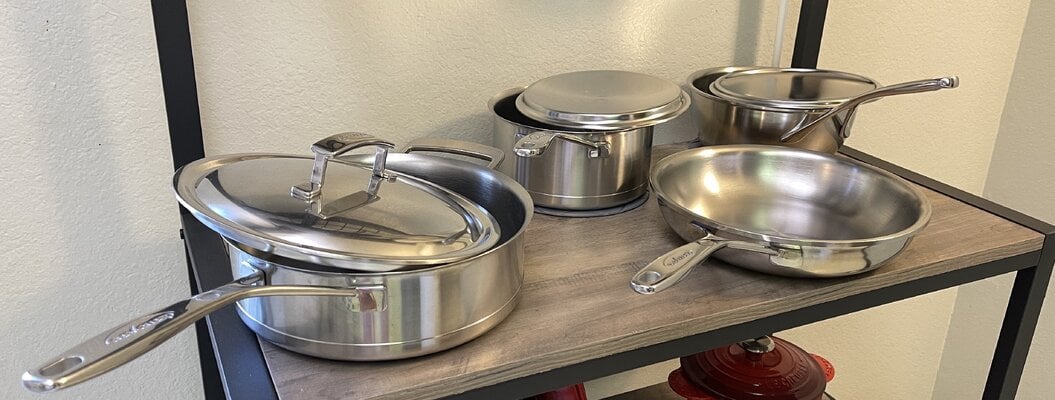
From left to right: 3.5qt Silver7 saute pan, 2.25qt Silver7 sauce pan, 9.5" Silver7 skillet (aka fry pan), 2.1qt saucier (aka conic saute pan)

The Silver7 sauce pan on the left, Atlantis saucier on the right. Note the double walled lid on the left vs. the single walled lid. Not significantly heavier: 0.92 lbs vs. 0.78 lbs although the lighter one is a little bit wider in circumference. Also note the rectangular weld contact point on the Silver7 (they all have this style) vs. the more "aerodynamic" (can't think of a better word) weld point for the Atlantis. I doubt both will ever fail, but I do think there is more contact area in the Silver7 weld point, but I have to say my eye likes the look of the Atlantis weld point more. Also note the Atlantis handle is more upward sloping, which I think is a consistent difference between the S7 and Atlantis.
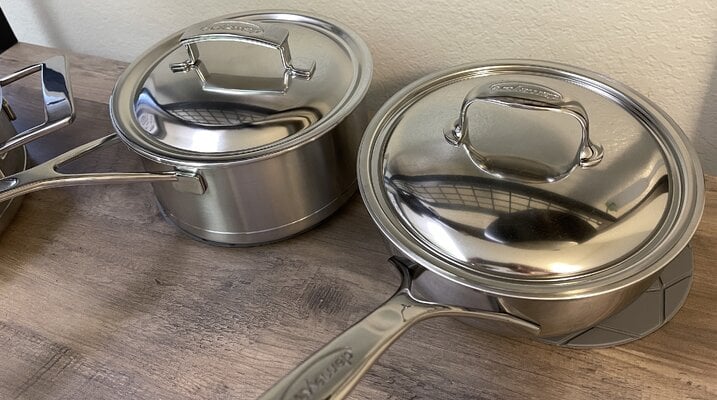
Note the shape difference in the lid handles. S7 has the rectangular/more angled style, while the Atlantis is more smooth and rounded (mirroring the differences in weld points).
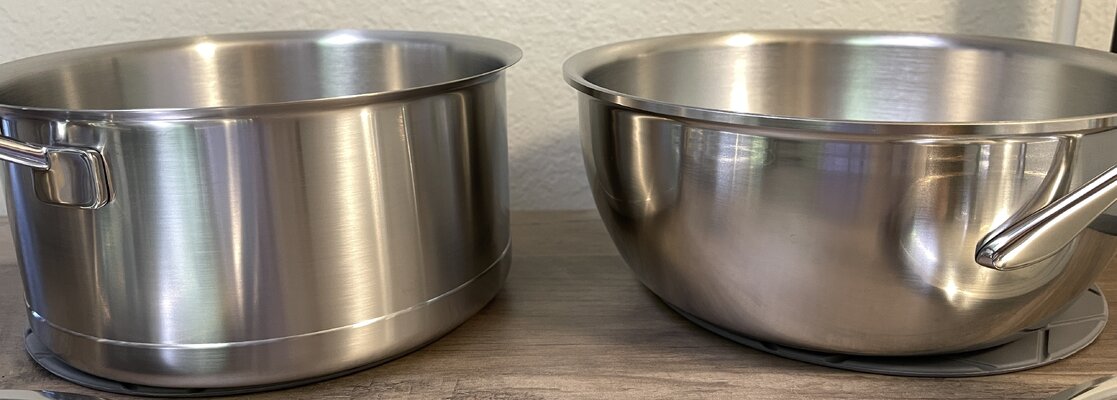
Disc bonded on the left (17mm with thick copper layer) and fully cladded on the right. Note the severe thickness difference at the nicely sloped (and sealed!) pouring rims. Whenever I have to "pour one out" there is very little, if any, dribbling down the sides.
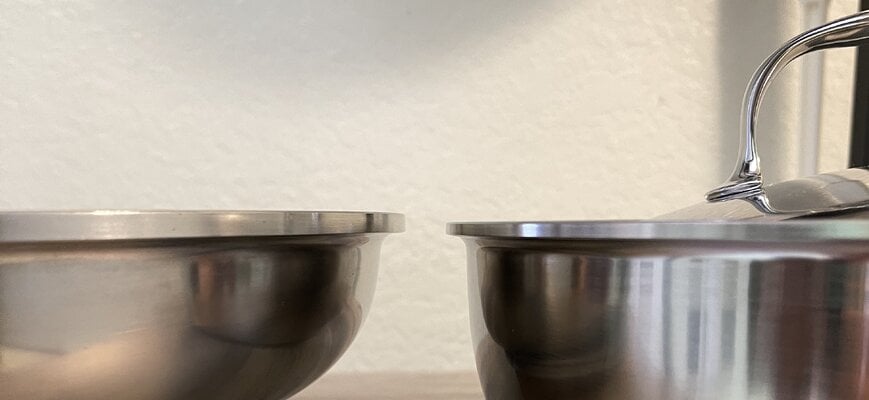
Fully clad thickness comparison: fry pan on the left at 5.3mm, saucier on the right at 3.6mm
Comments, thoughts and experiences are welcome!
If you are a stainless steel cookware fan, please post your pieces and thoughts on them! All Clad gets most of the name recognition in America, but internet direct companies like MadeIn are also making headway into the market space, claiming "All Clad" quality at lower prices. Hestan is trying to carve out a niche in the "more expensive than Demeyere" space (however small that market space is
 ) and of course I'd love to hear from those who own copper pieces. Outside of the added cost of copper, I'm also a bit wary of the added maintenance to keep/restore the shine on copper, which is why to this point I don't own any copper pieces.
) and of course I'd love to hear from those who own copper pieces. Outside of the added cost of copper, I'm also a bit wary of the added maintenance to keep/restore the shine on copper, which is why to this point I don't own any copper pieces.If there's enough participation and interest in this, I may do a second (third?) post in the CDC (Carlo Does Cookware) series comparing my Le Creuset and Staub pieces. The funny thing is that the basting dots on the lids of Staub ovens are called "Aroma Rain" by Staub. That has to rank right up there with Apple's "Dynamic Island" for me as a great concept with a horrible name.

Wishing you all peace, happiness, and good food! Don't eat to live, but rather, live to eat!
Last edited:

